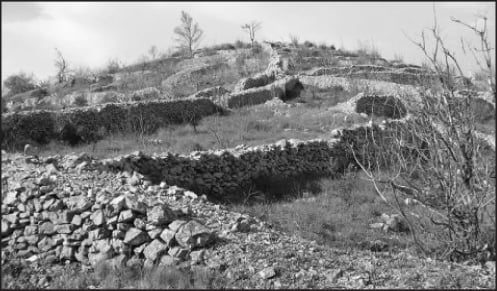Three years ago, half of the long, narrow Croatian island of Hvar burned, including 200-year-old Mediterranean pines and much of the island’s three major crops—lavender, grapes for wine, and olives. Fortunately, most of the larger towns and some of the villages were spared. Three firebombers tried valiantly, but the bora wind was so strong that, for three days, the fire raged. Finally, the wind dropped, and, in half an hour, the fire was extinguished, exposing the terraced hillsides and the enormous rock piles and thick rock walls that had been overgrown with trees and shrubs.
As in much of the world, people had been leaving the farms and villages, hoping that life in the mainland cities would be easier. Many actually found no employment and, instead, sit drinking coffee in dockside cafes, so they will be seen. The villages do not have many residents left; no one is tending the olive trees, and only a few are caring for the vines. All is overgrown and mostly abandoned.
Several hundred years ago, the Venetians sacked the island cities. People here say the fire was as bad as the Venetians. And perhaps it will happen again. Those who remain depend mostly on tourism. The bigger towns have hotels for package tours, and the big tour boats come to some, bringing shoppers during the day; but they are gone again for dinner aboard. Tomorrow, they will be on the next island.
And here, on Hvar, no one is working the thousands of terraced fields, which, even where the fire burned, will be quickly overgrown, making fodder for another fire. Some think the conflagration started simply by the strong sunlight intensified somewhere. It was that hot summer in Europe that you read about, and everything was exceedingly dry. Perhaps it was a careless cigarette—there are many, many smokers here.
Whatever it was, peace had only recently come to Croatia after what they call “the last war.” How many disasters can one people stand? They have had many. This disaster is perhaps of their own making.
There is no fresh water on Hvar. Until very recent times brought a pipeline from the mainland, all water had to be collected in cisterns. Fishing and farming were hard work. There were few luxuries.
But Hvar is called the seventh loveliest island in the world, with many trees and flowers. The old stone houses are strong and handsome. There were and are many churches, even now active. We attended the cathedral on the Sunday after Easter. It was crowded with children, young people, parents and older folk, too, but mostly the young. All seven of the handsome marble altars had lovely fresh flowers. The interior looked newly painted. Years ago, it took real hunger to encourage folks to leave. But now some seem to want glamour.
There is a little hope. Summer residents are buying some of the empty homes. But they don’t till the fields. A few people are making wine again, partly for the tourist business, of varieties that have long been native to this island. So, on some of the terraces, the vines are budding out, starting a new vintage. The wine is good.
We see many mothers wheeling their children about. Perhaps more of these children will stay and decide to fish, or press olives and make wine, making the terraced hillsides neat and green again.

Leave a Reply